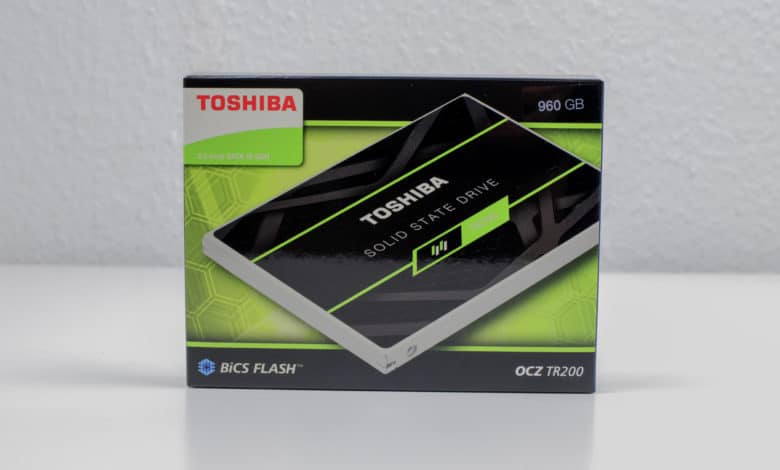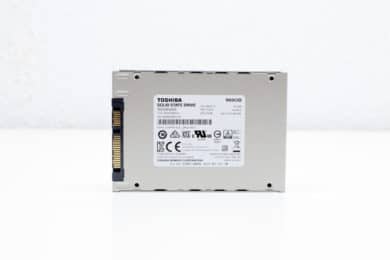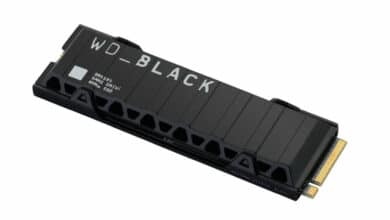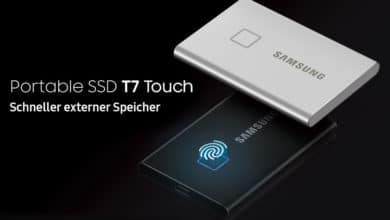
A long time ago KIOXIA (formerly Toshiba Memory) released the TR200, which was designed as a successor to the previous entry-level models. As the cheapest model, it should appeal especially to people who want to upgrade their PC memory in an uncomplicated and low-cost way and make it faster. In order to make the favourable price possible, a DRAM cache was omitted, which represents a rather unconventional measure. But not only for this reason the TR200 is interesting. It is also KIOXIA’s first SSD with 3D NAND of the BiCS3 generation.
Technical Data
| Form factor | 2.5 inch |
|---|---|
| available capacities | 240, 480, 960 GB |
| Cache | none |
| Controller | Toshiba TC58NC1010 |
| chip type | TLC (3D, 64 layers) NAND, 256 Gbit |
| Read (according to manufacturer) | 555 MB/s |
| Write (according to manufacturer) | 540 MB/s |
| MTTF | 1.5 million hours |
| TBW | 60, 120, 240 TB (depending on storage capacity) |
| Manufacturer warranty | Three years |
| Scope of delivery | SSD, Software “OCZ SSD Utility”, Warranty and installation instructions |
| Price |
Test system
- MSI Z370 Gaming Pro Carbon Mainboard*
- Intel Core i7-8700K Processor*
- 32 GB Crucial DDR4-3000 RAM*
- ASUS GeForce GTX 1080 Ti Strix Graphics Card*
Benchmark
- AS SSD Benchmark
- AS SSD Benchmark Score
- AS SSD Kompression-Benchmark
- AS SSD Kopier-Benchmark
- Crystal DiskMark
- ATTO Disk Benchmark
- HD Tune
- Zugriffszeiten
Everyday Experience
KIOXIA has been able to achieve a comparatively low price by dispensing with a DRAM cache, which makes the SSD interesting for beginners as well as for people who attach great importance to the financial aspect of their technical equipment. In addition, the elimination of the DRAM cache reduces power consumption compared to similar products equipped with DRAM cache, making the device more sustainable and less expensive to operate.
The DRAM is usually used for buffering the mapping table, in which it is stored where, i.e. in which areas of the NAND flash memory, data has been stored. If the DRAM is missing, no mapping table can be buffered there. This must then be distributed to the SRAM and to the NAND flash memory. Since the NAND memory is much slower than DRAM and SRAM, this type of storage is associated with performance losses. What sounds very abstract and uninteresting in theory is also noticeable in practice. Copying larger amounts of data takes comparatively long.
However, this does not mean that the TR200 is not suitable for everyday use. Normally, everything worked without any major problems. To be fair, however, it should be pointed out here that hardly any grandiose performance can be expected from an inexpensive entry-level model that is priced below most of its competitors’ products. The small weaknesses were thus quite expectable.
Fulness
The Toshiba TR200 offers both light and shade. On the one hand, it is very economical in terms of power consumption and only burdens the wallet to a small extent. On the other hand, it lags behind the competition in terms of performance. A clear judgement is therefore not easy to make. On the positive side, we would also like to point out that KIOXIA has dared to convert this model to the 3D BiCS NAND memory, which in our opinion is extremely positive.
Ultimately, the evaluation is very clearly a question of perspective. Those who attach great importance to high performance will be disappointed by the TR200. If he buys it, he is to some extent to blame himself, however, KIOXIA advertises very offensively with the fact that it is an entry-level model. Flying high can hardly be expected from such models. Those who want to save money and power and are willing to forego outstanding performance can be happy with the SSD – especially if it changes from a much slower HDD. But don’t forget that there are even cheaper models.
Toshiba TR200
Access Times
Transfer Rate (read)
Transfer Rate (write)
Value for Money
An inexpensive entry-level SSD that, unfortunately, is not completely convincing.







